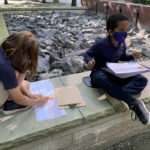The COVID-19 (Coronavirus) pandemic reshaped the education landscape in a matter of months, as schools were forced to go virtual. IB World Magazine speaks to two experts on how this experience will impact teaching and learning in the future.

For one and a half billion students around the world, the COVID-19 (Coronavirus) pandemic will be a defining moment in their school lives. More than 190 countries have implemented school closures in response to the outbreak, affecting 90% of the world’s students, according to UNESCO. A new generation of virtual learners were born with weeks, schools had to experiment with new online learning platforms and parents had to provide the hands-on support teachers normally offer in classrooms.
The Royal College of Paediatrics and Child Health in the UK has said that the effects of school closures risk scarring the life chances of young people, with students from under-resourced communities suffering the most. Left unchecked, COVID-19 will exacerbate existing problems and deepen structural social and health inequalities.
Identifying educational gaps
Access to electronic devices and the internet is a huge determining factor in whether students were able to continue their education during school closures. According to the Digital 2020 report, only 60% of the world’s population is online so many students will not have had adequate access to distance learning, which is likely to cause educational gaps. Students who have had difficulties coping with the transition to online learning or have not received enough parental support during school closures will also have suffered from being outside the classroom.
“The first focus should be identifying gaps at pace and as accurately as possible”.
“Historically, we know that learning gaps emerge whenever students are out of school—for example, during summer holidays, through absenteeism or during natural disasters”, says Stephen Fraser, deputy chief executive at the Education Endowment Foundation (EEF), a charity dedicated to breaking the link between family income and educational achievement.
“The modelling we have done shows that the gap during COVID-19 is likely to widen anywhere between 11% and 75%, depending on which countries have access to digital technology and can switch to remote learning more easily”.
As schools start to welcome students back into the classroom, identifying education gaps will be important to ensure no child falls through the cracks. “The first focus should be on identifying gaps at pace and as accurately as possible, but not necessarily through standardized assessment—observations and speaking to students and their parents can help identify these gaps”, says Fraser.
Once students have been assessed, tutoring can help get them back on track. “Additional one-to-one or group support will be one of the most effective ways to rapidly support under-resourced students to get back into the rhythm of learning quickly”, says Fraser.
Mental and social impact
While educational gaps can be identified, the mental and social impact of school closures could be harder to quantify. School provides a safe haven for many students, which the pandemic has taken away. “We do know there will be a small proportion of students for whom lockdown will have been disastrous—they would have been in family environments where access to food security would be a challenge, or where they would have been subject to abuse or violence”, says Fraser.
“The forced risk-taking in online learning has been a step-change in innovation”.
However, Fraser warns that schools should be careful not to make assumptions about which students have suffered or benefited from the circumstances of the lockdown. “There will be under-resourced students for whom lockdown will have been a positive experience—they might have suffered from bullying at school or had low self-esteem. Having a break from that environment will provide a circuit-breaker for those relationships. Equally, there will be more fortunate students who have really suffered through this period”.
A technology revolution
The switch to online learning during school closures represents the biggest educational technology experiment in history. Harnessing technology has proven to be vital for schools. Within weeks, teachers had to decide how to deliver lessons and package resources virtually, using new digital learning platforms.
Professor John Hattie, author of Visible Learning and director of the Melbourne Education Research Institute at the University of Melbourne, Australia, says technology in itself has had little impact on educational outcomes in the past, but lockdown has presented a unique opportunity. “If you look at the 200-plus meta analyses on technology in education since 1976, the effect has been very small. However, we threw that out the window with COVID-19, and suddenly teachers had to depend on technology”. Hattie says this has forced teachers to release responsibility for control over their classes and allowed students to become more active in their own learning.
“If students don’t know something when they are in the classroom, they don’t put their hand up—they sit there and pretend they understand, because they don’t want to interrupt the teacher or get any negative feedback from their peers”, he says. “But online, they will talk to other students—it has enormous potential to create a new subtext of learning”.

Interactive apps can help encourage this self-reflection and pitches the work at a level where students are stretched but not overwhelmed. “Educational apps are good at utilizing the ‘Goldilocks principle’ of challenge—not too hard, not too easy, not too boring”, says Hattie. “Teachers often give students tasks depending on their ability, which locks them in. But with apps and games, when a child gets to one level of success, the challenge is raised and he or she wants to keep playing. That’s what we’ve got to bring back better after COVID-19”, he says.
For Hattie, the most exciting use of education technology during lockdown has been how it connects students to their peers. “Most students are into the social use of technology in dramatic ways—sometimes for the negative, sometimes for the positive—but using the social aspect of technology is the biggest learning we need to get out of this experience”.
Fraser agrees there’s a huge opportunity to do things differently without losing sight of what’s important. “The forced risk-taking in online learning has been a step-change in innovation—we have schools and students doing things that they never would have done before”, he says.
“The risk is that when we go back to face-to-face schooling we won’t know whether those ways of learning were more impactful—whether they led to more engagement or disengagement. To borrow the words of a colleague, they could leave a ‘legacy of activity but not a legacy of knowledge’. The quality of the relationship between the teacher and the student is the key driver in whether those new ways of working have an impact or not”.
A chance for change
Hattie says it is crucial that schools don’t squander this opportunity for change: “My plea to teachers is to keep a learning log during distance learning about what works well and have a really robust discussion about what you want to stop and what do you want to bring back”.
After experiencing several waves of school closures in Australia, Hattie says distance learning practices have already been refined. “In the first wave of closures, we tended to package students’ work and give it to them to do, as well as delivering lessons online. The second time, we realized that some students didn’t know what to do when they were struggling, so teachers started to package the work differently—they were more clear about what success looked like in smaller steps, and encouraged the students to work together. We need to speed that process up, and stop doing the same things online that we do in the classroom”.
“The capacity to learn, adapt and be resilient comes from engagement in education”.
Learning at home also tends to be much more intensive, without interruptions from assemblies, recess or other school activities: “We realized that students can often complete work a lot faster at home than at school—so during the next wave of school closures teachers weren’t as obsessed with ‘time on task’. They were much more interested in helping students pace [themselves]”, he says.
Reflecting on the experience
Assessing the successes and failures of virtual learning in this way will be of utmost importance as the pandemic continues. Increasing access to electronic devices for students of all backgrounds, providing extra training and support for teachers and offering tutoring for those who need extra help will also be necessary to ensure education is more equitable.
Education leaders must use this time of reflection to ensure that students are equipped with the skills to tackle the new world we are living in. Education remains central to our future prospects and resilience in facing future global risks, including the threat of climate change.
“The capacity to learn, adapt and be resilient comes from engagement in education”, says Fraser. “These are the protective factors for all of us throughout our lives. Maybe there’s no reason to revisit the whole purpose of schooling, but to emphasize the importance of every child coming out of this pandemic well prepared to handle whatever challenges humanity faces next. Building robust literacy, numeracy and critical thinking skills in students is one of the strongest bets we have”.
If you enjoyed this story, consider reading more below:



